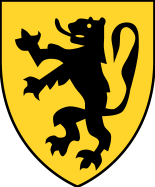This article needs additional citations for verification. (March 2010) |
| Flemish Legion | |
|---|---|
 Sleeve insignia of the Flemish Legion, based on the traditional iconography of the Flemish Movement. | |
| Active | 1941–1943 1943–1945 |
| Country | |
| Allegiance | |
| Branch | |
| Type | Infantry |
| Size | Battalion, brigade and later division, though never larger than brigade-strength. |
| Engagements | |
The Flemish Legion (Dutch: Vlaams Legioen) was a collaborationist military formation recruited among Dutch-speaking volunteers from German-occupied Belgium, notably from Flanders, during World War II. It was formed in the aftermath of the German invasion of the Soviet Union and fought on the Eastern Front in the Waffen SS alongside similar formations from other parts of German-occupied Western Europe.
Established in July 1941, the Flemish Legion was envisaged by the Flemish National League (Vlaamsch Nationaal Verbond, VNV) as a means of maintaining its status as the principal collaborationist party within Flanders since the German invasion of May 1940. It was formed several months after the VNV had begun recruiting Flemish volunteers for smaller Waffen SS formations and was depicted as the future army of an independent Flemish state. Amid opposition from its personnel, the roughly 1,000-strong formation was given a notionally independent status as an SS Volunteer Legion Flanders (SS-Freiwilligen Legion Flandern). It subsequently sustained heavy casualties on the Eastern Front in fighting around Leningrad.
The Flemish Legion was officially disbanded in May 1943 and reformed within the Waffen-SS as the SS Assault Brigade Langemarck (SS-Sturmbrigade Langemarck). 200 soldiers refused to swear allegiance to Adolf Hitler in October 1943 and were transferred to other units or penal units. It was subsequently reorganised on several occasions and was officially designated as a division in September 1944 but remained around 2,000-strong and never expanded beyond brigade-strength. It participated in fighting in Ukraine, Estonia, and Pomerania. Its remaining personnel finally surrendered to the Red Army at Mecklenburg on 3 May 1945.
- ^ Littlejohn 1972, p. 166.
Cite error: There are <ref group=lower-alpha> tags or {{efn}} templates on this page, but the references will not show without a {{reflist|group=lower-alpha}} template or {{notelist}} template (see the help page).